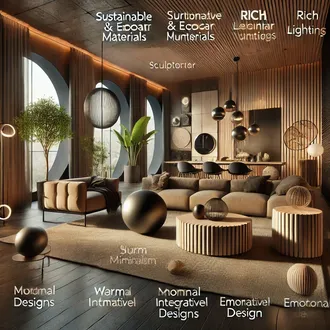Transcription Artificial lighting
Due to the constant technological advances in artificial lighting, it is becoming more and more important in the decoration of interior spaces, constituting an essential tool to give life to all projects and in some spaces, it can become the most important element to develop a decorative idea.
In this presentation we will know the different types of artificial lighting, as well as its main characteristics and applications in interior spaces.
Types of artificial lighting
Artificial lighting is generally classified according to three different criteria:
- Taking into account its function it is classified into: general, punctual, ambient and decorative.
- Taking into account the technology of the light sources, it is classified into: incandescent filament bulbs, incandescent halogen bulbs, fluorescent or discharge luminaires, light-emitting diode devices -LED-.
- Taking into account the lighting system, they are classified as: direct, semi-direct, semi-indirect and diffuse.
Types of artificial lighting taking into account their function.
- General lighting: Its main function is to allow safe movement through a space, without perceiving disturbances due to lighting differences or shadows in certain areas -the light does not have to be very intense, and can have a slightly warm color-. Generally, luminaires are placed on the ceiling, the ceiling or on the walls -always somewhat above our eyes-; the switches to turn them on and off should be located next to the access points to the premises. General lighting is usually used in all the rooms of the house.
- Spot lighting: Its main function is to provide a greater luminous intensity on a sector of the space, in order to improve visual comfort for the performance of specific tasks. When placing punctual luminaires, we must avoid that they cause glare, shadows and annoying contrasts. Spot lighting is used in kitchens; in study or reading areas; in bathrooms, and so on.
- Ambient lighting: Its main function is to contribute to generate different atmospheres in certain rooms or areas of these, to provoke other sensations - greater warmth, proximity, intimacy, etc. -. The creation of atmospheres contributes to break the monotony that can be caused by general lighting in the interior space. It can be used for housing.
- Decorative lighting: It is used to highlight a certain object or decorative element -a painting, a plant, a sculpture, etc.-. The colors and intensities of the decorative lighting, as well as the places where it is used can be very varied, since they depend on the imagination and the aesthetic effects that the decorator intends to achieve.
Types of artificial lighting taking into account the technology of the light sources.
- Incandescent or filament bulbs: They produce light from the incandescence caused by the passage of current through a tungsten filament inside a glass bulb. They are the light bulbs with the lowest luminous efficiency, which is why they are being replaced all over the world by other more economical and higher performance bulbs.
- Halogen incandescent bulbs: They have the same operating principle as incandescent bulbs, but inside the glass bulb a small amount of halogen (iodine or bromine) is added to improve the performance of the filament and prolong its life; also the glass of the bulb is replaced by a quartz compound that allows it to withstand higher temperature. They emit a continuous spectrum of light that can vary from warmer to cooler colors.
- Fluorescent or discharge luminaires: They operate on the basis of the visible light emitted by some gases enclosed at low pressure when they receive ultraviolet radiation. These lamps consume less electrical energy than incandescent lamps, and their useful life is also longer. The light they emit is cold. The most commercially available are fluorescent tubes and compact fluorescent bulbs (CFLs).
- Light-emitting diode (LED) devices: These work on the basis of the light emitted by a semiconductor material - a diode - when it is subjected to a certain electrical voltage between its two terminals. LED technology offers the following advantages for the decorator.
There is a great variety of LED devices that produce light with very different characteristics: different intensities, colors, shapes, etc.
Their energy consumption is considerably lower than that of other artificial light sources:
- A much longer lifetime.
- A smaller size.
- A less fragile physical condition.
Types of artificial lighting taking into account the lighting system.
- Direct: It is produced when between 90% and 100% of the luminous flux is directly directed to the floor, to an area or to a decorative object; usually this effect is achieved by using screens or reflectors. When using direct light, possible glare, contrasts and unwelcome shadows should be avoided.
- Semi-direct: It is produced when most of the luminous flux -60%- is directed towards the area we want to illuminate and the rest is directed towards other areas of the room, in a diffuse or reflected way. This effect can be achieved by using bottomless globes, floor lamps, table lamps, etcetera.
- Semi-indirect: It is produced when the smallest part of the luminous flux -40%- is directed towards the area to be illuminated and the rest towards other areas of the room in a diffuse or reflected way.
- Diffuse: The luminous flux is made to pass through some element that filters it, making it bounce in different directions, so that it reaches all points with equal intensity and does not cause shadows or glare of consideration. This effect can be achieved by using completely closed diffuser balloons.
- Indirect: It is the one in which the totality of the luminous flux is directed towards the ceiling and by reflection it arrives uniformly to all places of the space. High quality illumination is obtained, without shadows or glare. It is more expensive due to absorption losses.
artificial light




